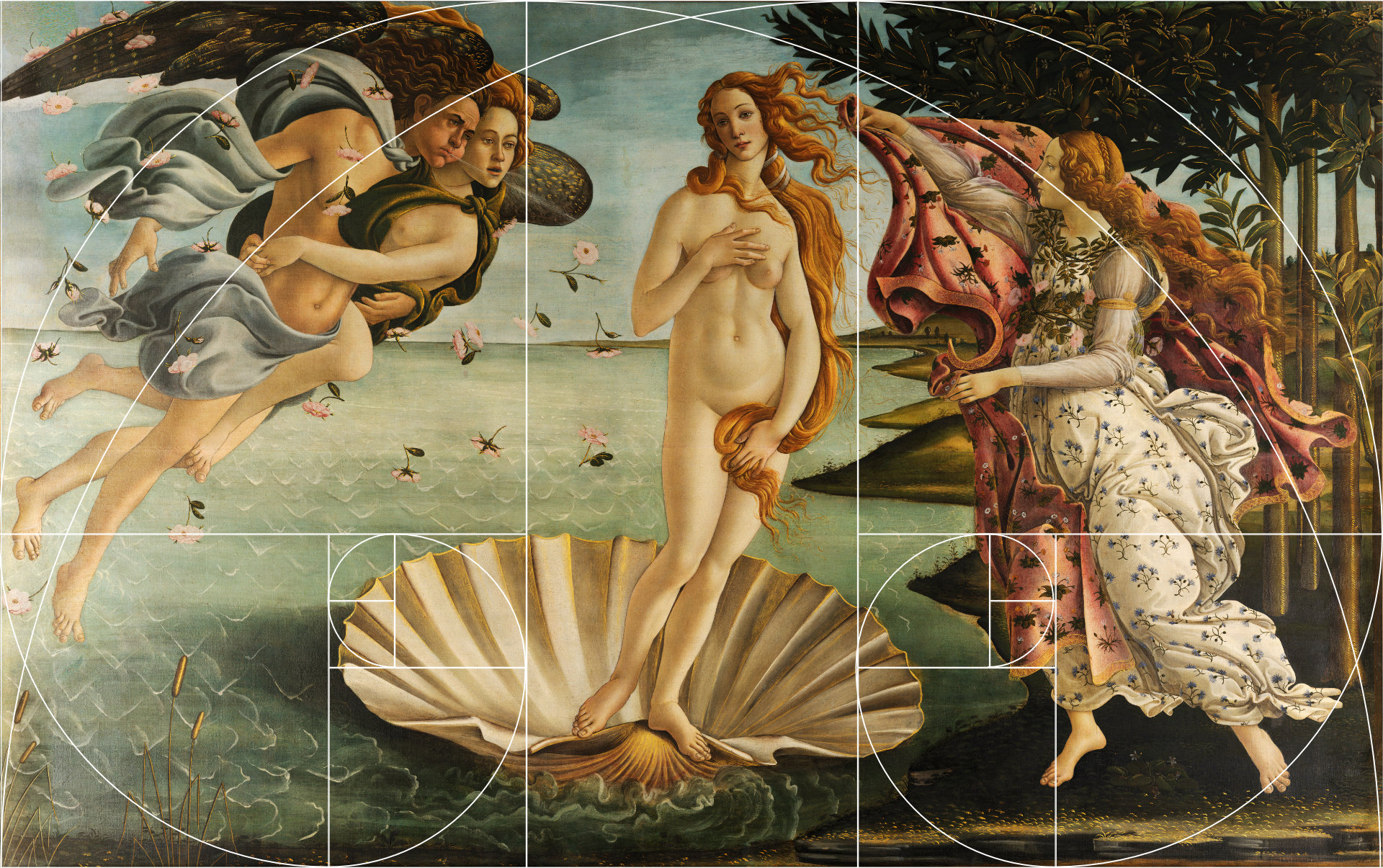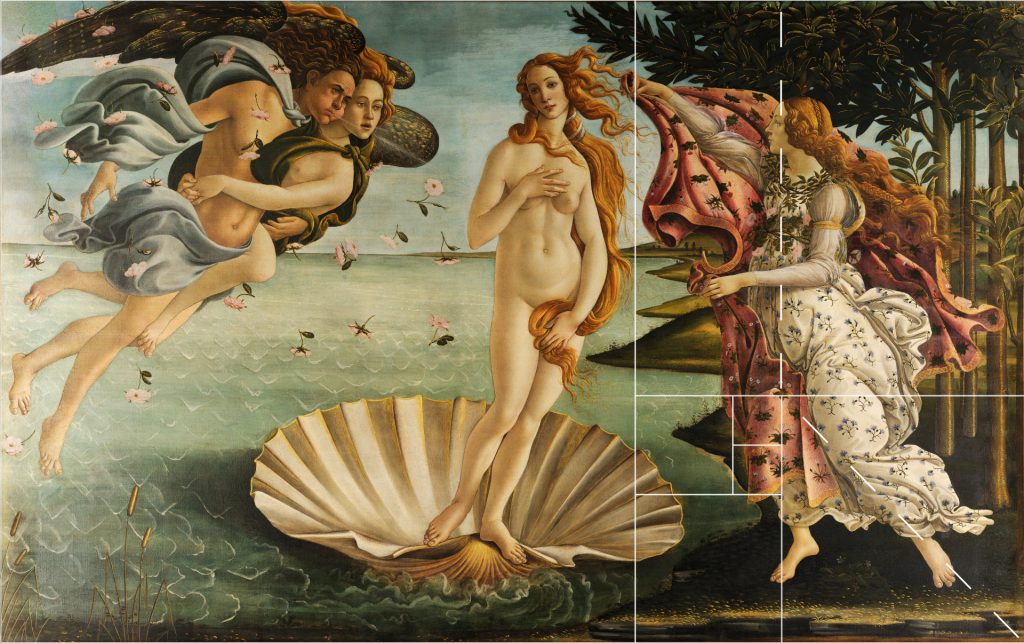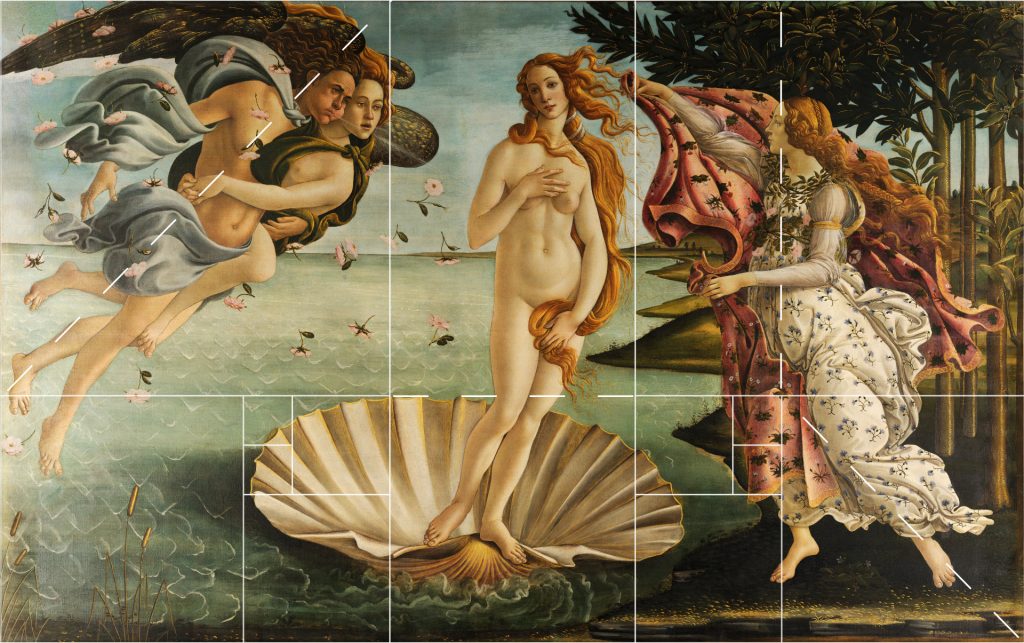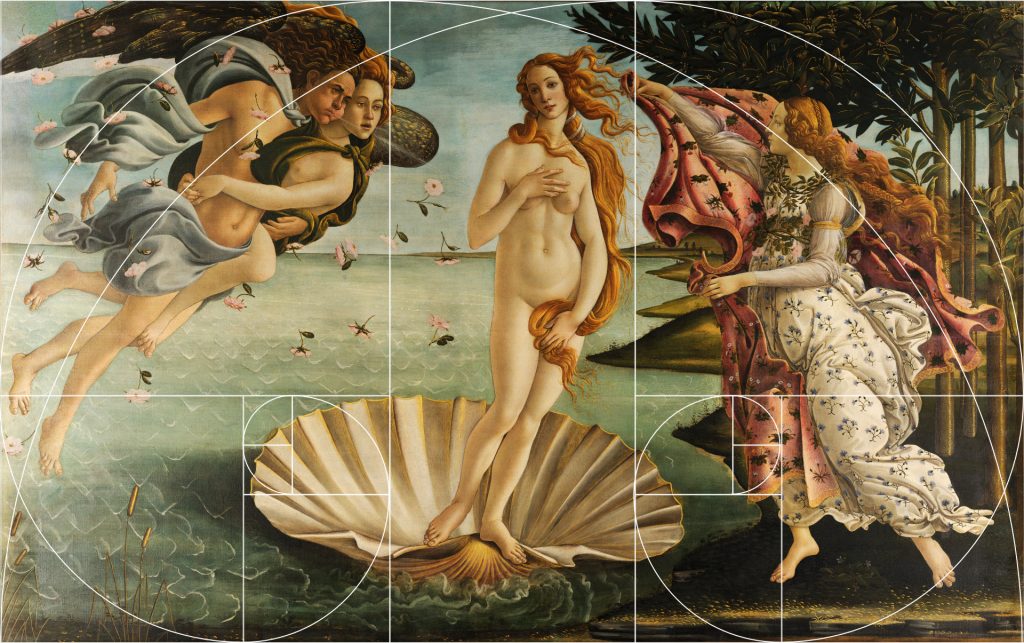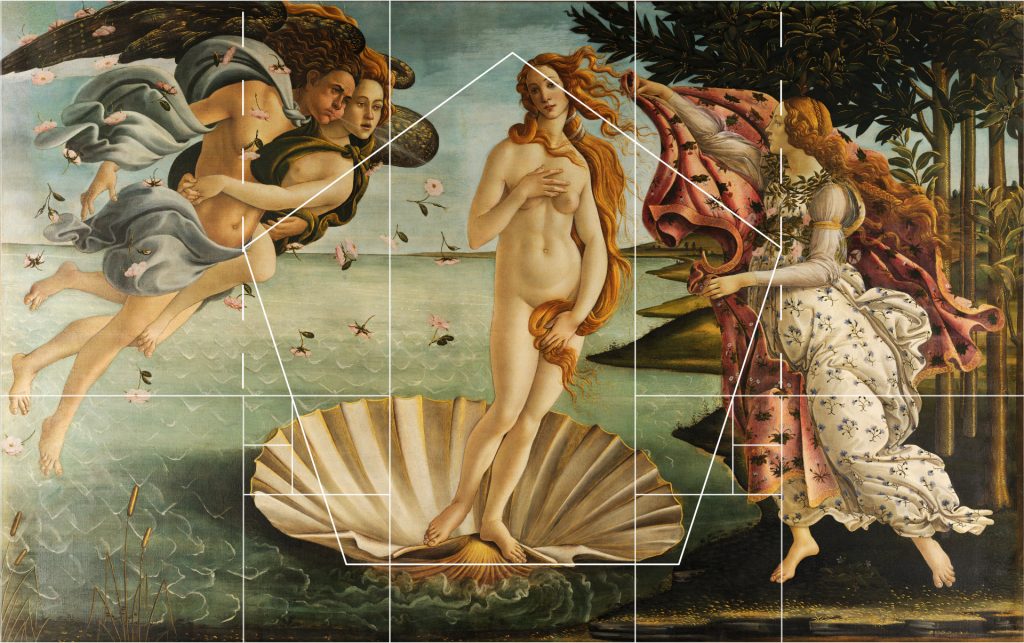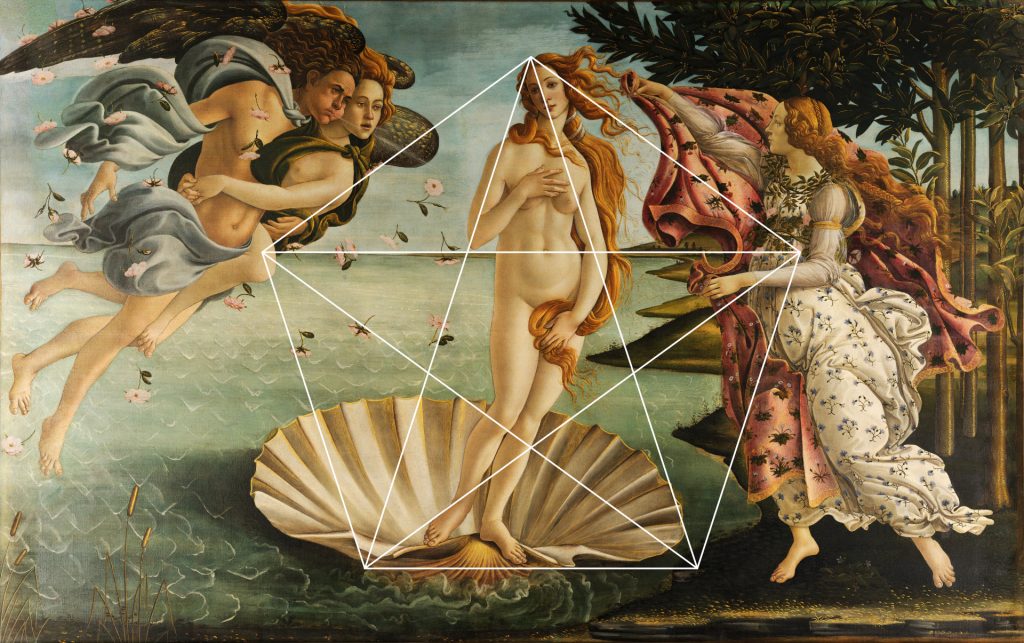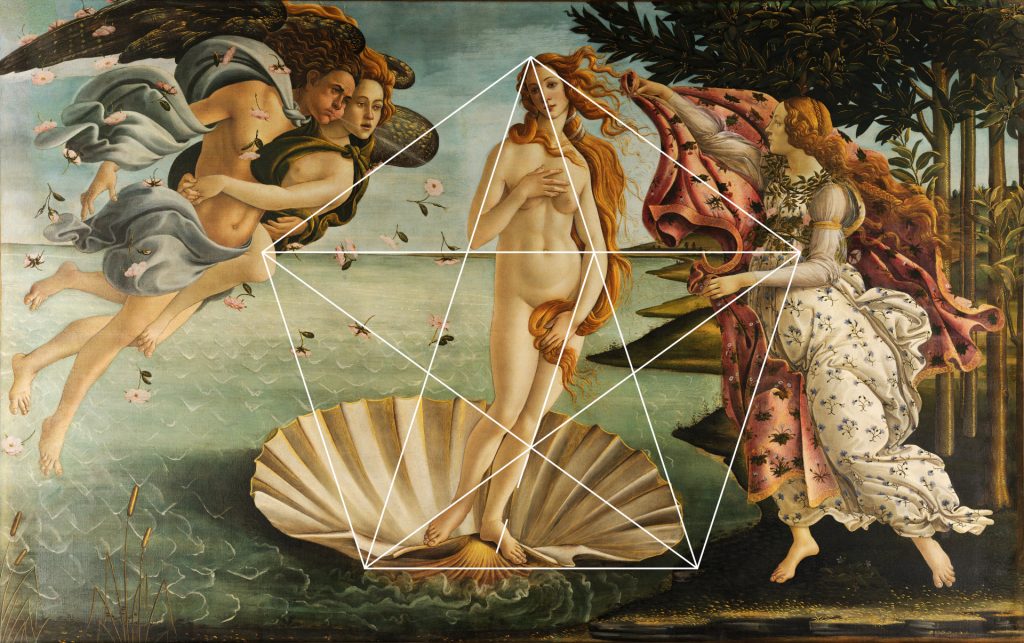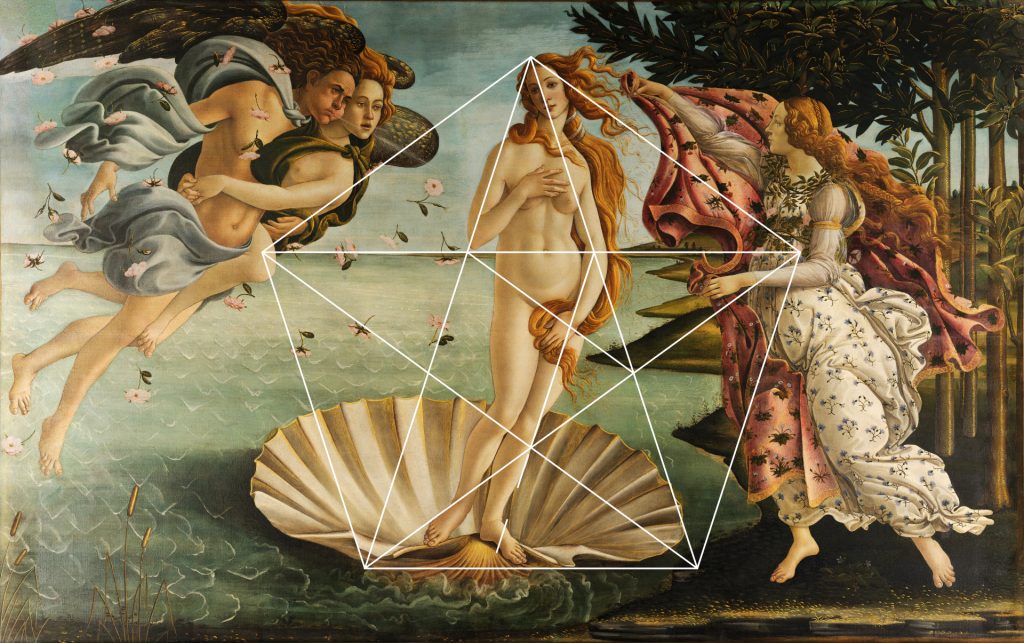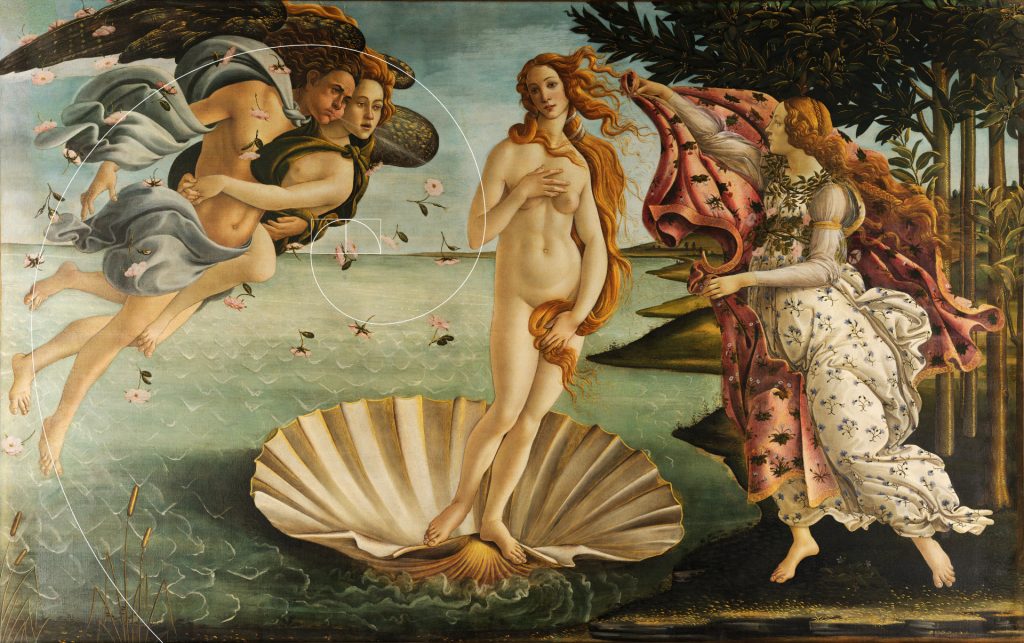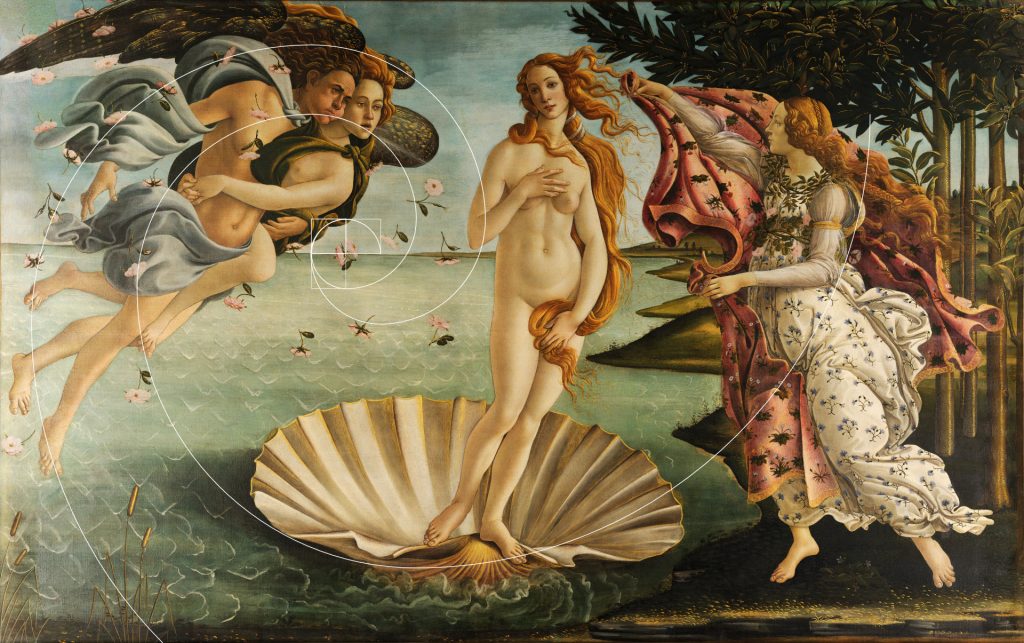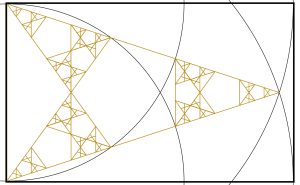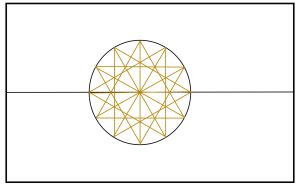In this article we will be looking at the use of Φ(Phi), or rather a very specific approximation of it, in the construction of this painting. The Birth Of Venus dates from around 1485 and is emblematic of the Italian Renaissance.
THE CANVAS
When studying the Birth of Venus, the first thing to note is the canvas size. There are two measurements given. These are 278.9cm by 172.5cm (metric) or 109.6 inches by 67.9 inches (imperial).
If we take the ratio of these measurements we end up with the following. 1.616811594 (metric) and 1.614138439 (imperial). These are both close to but not exactly Φ(Phi) (1.618…).
If we take the average of the two values we get 1.615475017.
We will presume that this is a close approximation of the actual canvas ratio.
Presuming that this canvas was created via the usual method of creating a Golden Rectangle (see here), we will look at the values of Φ(Phi) as given by the ratio between consecutive Fibonacci numbers.
| Pair | 1:1 | 1:2 | 2:3 | 3:5 | 5:8 | 8:13 | 13:21 | 21:34 |
|---|---|---|---|---|---|---|---|---|
| Fn+1/Fn | 1 | 2 | 1.5 | 1.66 ̇ | 1.6 | 1.625 | 1.615… | 1.619… |
We see the value we have is close to the ratio between 13:21. The full value is of this ratio 1.615384615.
If we compare this to our value, as given above, we find the difference is 0.000090415. As a percentage of the true value of 13:21, this is 0.005596283335%.
Put more simply, the canvas is off of the true value of 13:21 by less than six thousandths of a percent. For this reason we will presume that this 21:13 Golden Rectangle is the template used.
The second source of error is the dimensions of the publicly available file. The file is 30,000 pixels by 18,840 pixels (212Mb). This file has thus has a value of phi of 1.592356688 suggesting it is slightly too narrow. This value of phi is 1.431054566% off that which was expected. This could be an artefact of the camera or as a result of some of the canvas being under the frame. Regardless, this is the best image available. I have presumed that the image as shown is the full image and that what we are seeing is a distortion in the camera lens. I have thus adapted the tools given below to the proportions of the image presuming an approximate 1.5% error in proportions as caused by the camera.
With these limitations in mind we will proceed.
TOOLS USED
Given the 21:13 ratio of the image, the following template was used with proportional width 21, proportional height 13.
Notice the 13:8 division line. This is the exact harmonic which makes the ‘first rose of heaven’ as Venus dances around the Earth.
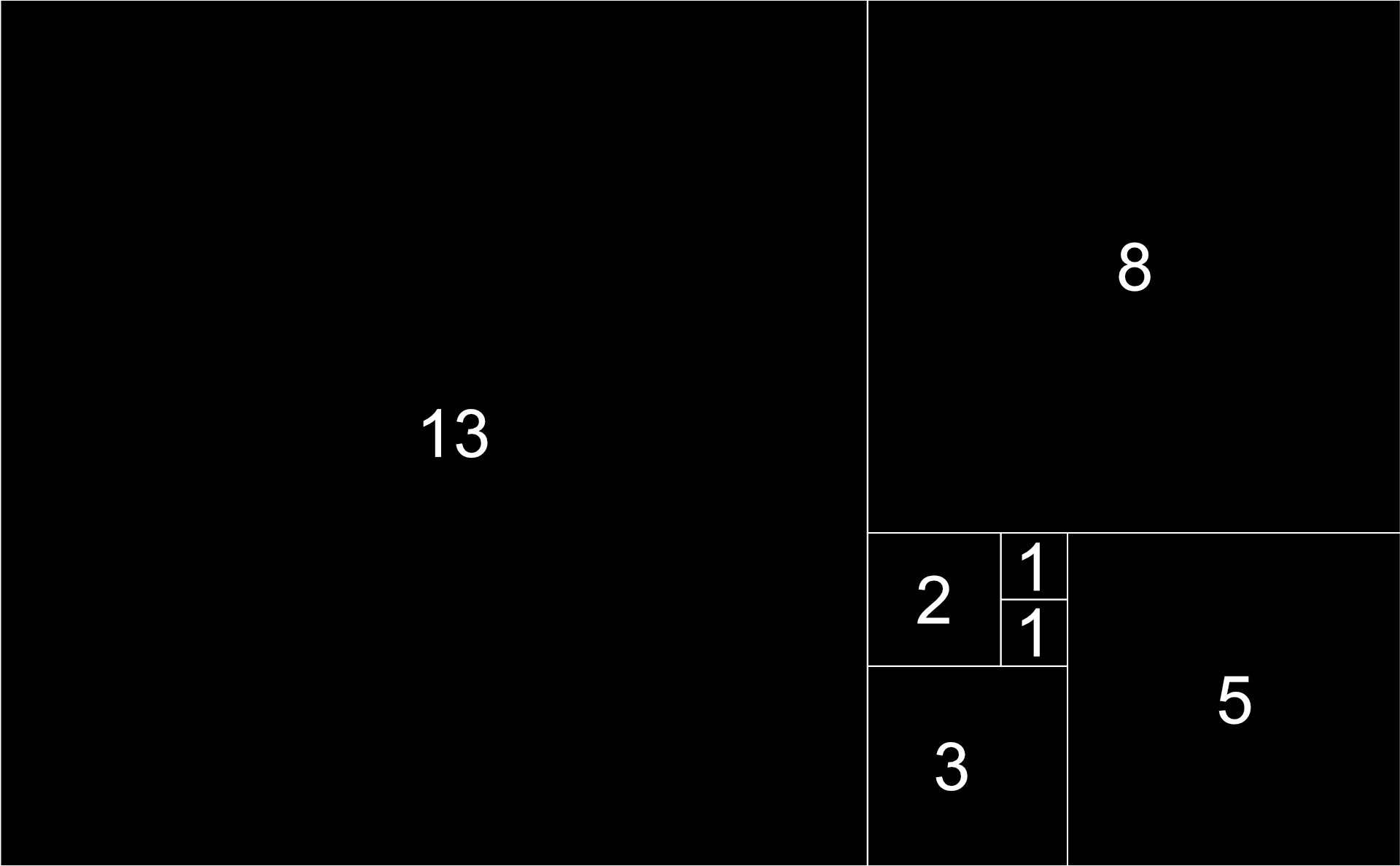
The golden spiral used was created from the above as follows. Instructions on how to make your own can be found here.
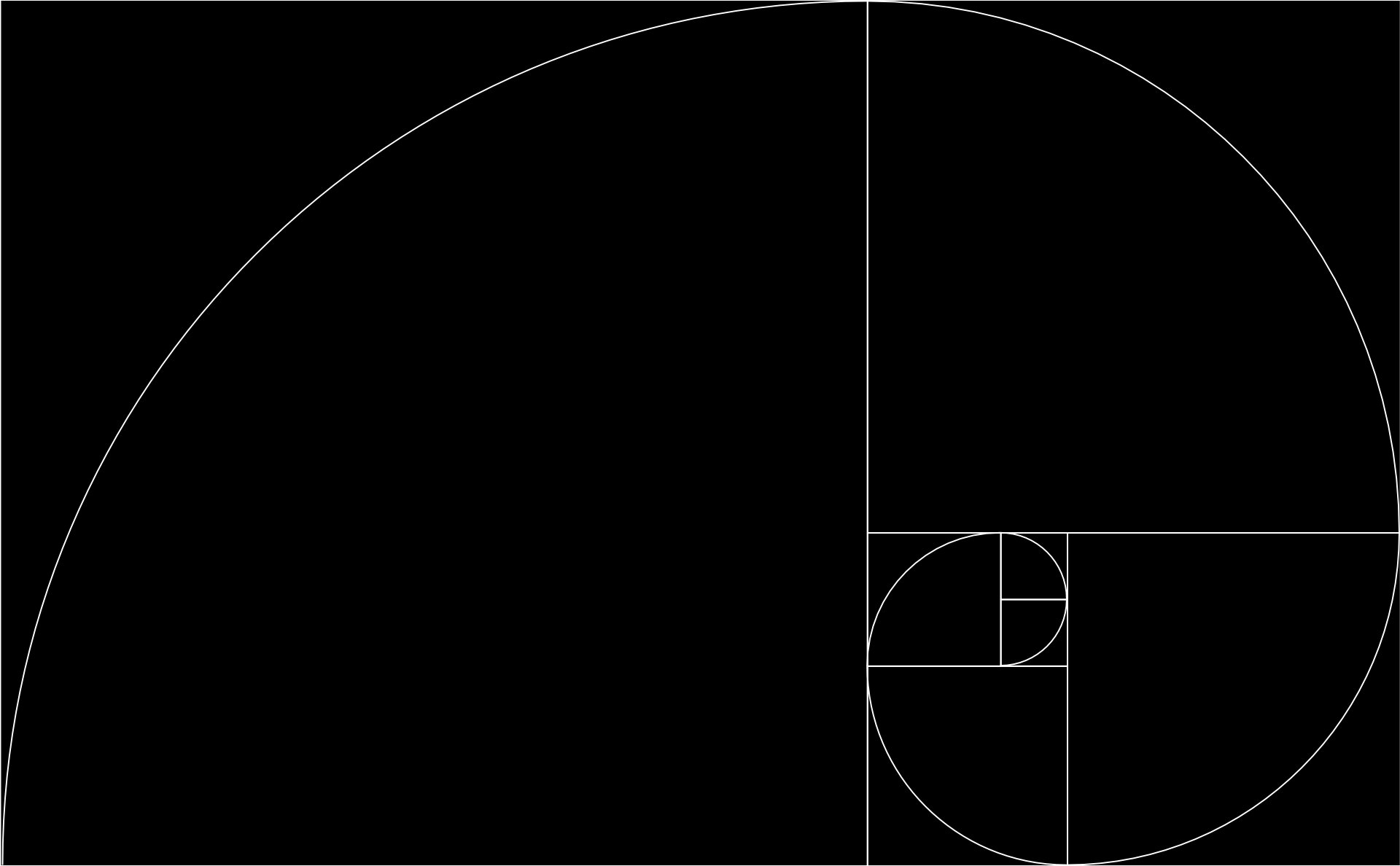
I will be using proportional measurements when describing the painting. I did research ancient measurements (Egyptian and Greek) but I could not find any close match.
For completeness, the unit value of this painting is 13.280cm or 5.22 inches.
As a reminder, this 13:8 resonance is representative of the 13:8 resonance seen between the orbital periods between the planet Earth and the planet Venus. This was written about here. Below is an idealised representation of the pattern Venus makes if observed from Earth. Note the five pointed ‘rose’ which emerges. This has been observed by stargazers since antiquity.
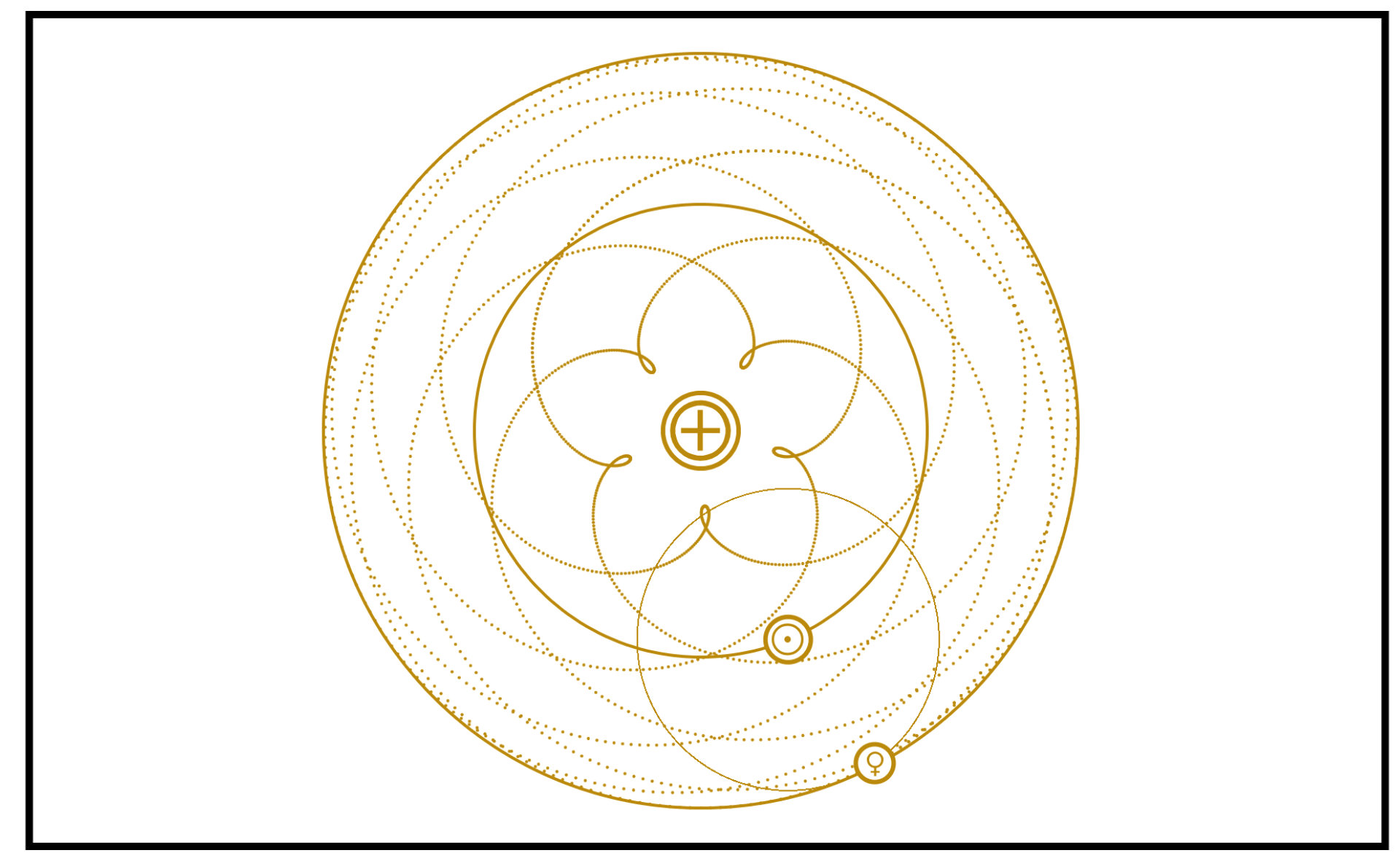
THE CHARACTERS
 The Goddess in the middle needs no introduction. She is in this manifestation, of course, Venus or perhaps, as we will see, more accurately called (1)Aphrodite.
The Goddess in the middle needs no introduction. She is in this manifestation, of course, Venus or perhaps, as we will see, more accurately called (1)Aphrodite.
The two winged characters on the left are thought to be (2)Zephyrus, the God of West Wind and God of Spring, and (3)Aura, Titaness of the morning breeze. It is interesting to note the connection between Aura and the Mysteries of Dionysus.
To the right is (4)Eirene, Goddess of Spring and one of the three Horae. It is interesting to note that these three sisters of the Moirai (Fate) not only controlled the seasons but also the stars and constellations in Heaven. In some traditions the Moirai, the fates, stood above even the Gods themselves, being the ultimate manifestation of cosmic order.
THE DISTRIBUTION OF THE CHARACTERS
If we directly superimpose the 21:13 golden rectangle on the image, we see it perfectly frames Eirene on the right.
Note the back leg at 45°, nearly perfectly bisecting the bottom right square. Also note how her centre of gravity is placed exactly over the line as indicated by the vertical dotted line. Notice how the edge of the cloak breaks through towards the Goddess. This broken symmetry is masterfully used time and again in this painting to suggest dynamic movement.
If we invert the the golden rectangle horizontally we find the same is true for Zephyrus and Aura. They are (nearly) perfectly framed by the top right square (denoted by the top right diagonal dashed line).
You can see the edges of the wings just pushing towards the Goddess, again, just breaking the symmetry for dynamic effect.
Notice how the bottom dotted line defines the top edge of the shell.
If we superimose both Golden Spirals you can see how they perfectly frame both Eirene and Zephyrus and Aura. These spirals seem to assist in the flow of movement in the painting.
This also shows us that the Goddess is standing slightly off centre, as she is stepping forwards from the shell. Another example of the broken symmetry already mentioned.
THE GODDESS HERSELF
Now we turn to the Goddess. Note how her head is slightly tilted from the horizontal. If we measure this angle we find that she is holding it at 72°/108°.
These are the interior and exterior angles of the pentagon.
Notice how half her face is in shadow. The only pronounced shadow on the body of the Goddess.
We now define a pentagon with a width equal the gap between the two dotted lines. This gives a pentagon with a relative diagonal of 11, and a height of 10.46, which is very close to half the width (21) of the painting.
As already mentioned, the Goddess is stepping forwards to the right so is slightly off center.
We can move the pentagon into position around the Goddess. We can see that it very closely matches her height. Were she standing upright it could very well be perfect, however, she is in the process of walking, hence her gait.
Notice her hair flowing down with the top right side of the pentagon connecting to the arm of Eirene. Notice how Zephyrus and Aura also frame the pentagon.
We can now draw the two diagonals shown. The right one of these bisects her face and gives us the orignal 72°/108° angle we used to determine the use of the pentagon here. This shows the Goddess is standing within a Golden Triangle. See how her poise tilts her upper arms to be in line with the two diagonals.
Also note the sea is lower between her and Zephyr than it is behind Zephyr. A very subtle technique used to enhance the subconscious impression of the pentagon.
We can now draw in the horizontal diagonal. Notice how it perfectly touches her elbows, passes through her navel and passes through where her body angle changes.
Also note how the right arm of Eirene, held at right angles. This again accentuates this line. See how the rear leg of Aura, held parallel, continues it to the left.
It also pierces the double rose. the only double rose in the painting. We will come back to this shortly.
Finally, as we know the top triangle is also a Golden Triangle, we can draw the bisecting line forming a smaller Golden Triangle and the Golden Gnomon.
Notice how her arm crossing her chest suggests this line.
VORTEX OF ZEPHYRUS AND AURA
Given the nature of the roses, being blown to the wind, I must be less precise in this section. However it is my opinion that some similar method was used to aid in the arrangement and distribution of the roses. Below is my current best guess but I am less certain that I am exact of the below than I am the above.
For completeness I add the last two spirals, again, you see they seem to accentuate details we have already mentioned. How Eirene is just leaning in and breaking the line again, and how the Goddess seems to rest her head on the curve.
This, by its nature, is harder to pin down. Perhaps I have the spirals slightly incorrect, however I feel that the double rose acts as a focal point of the dynamic energy on the left hand side of the painting. Something along these lines was used.
GEOMETRIC ANALYSIS OF THE BIRTH OF VENUS
To my eye, the above shows quite clearly that Botticelli was making a profound statement with this work. Not only are there multiple layers of meaning to his choice of actors in this painting, there is also a reference to the astronomical motion of the planet Venus as well as a thorough exposition on the use of Φ(Phi)to obtain a beautiful harmony of proportions. On top of this there is the masterful use of the broken symmetry by which the strict proportions broken to suggest a certain movement and dynamic energy. Through all this he is articulating, very clearly, ancient wisdom veiled through the medium of painting.
My interpretation of the painting is thus as follows. The Goddess, herself representing a deep universal harmonic order as denoted by the use of the pentagon to frame her, is stepping forwards from the epheral world of air and sea, to material reality, represented on the right of the image by the land, the right angles of the trees and the 45° inclination of the rear leg of Eirene and her arm held at near a right angle. The use of the God and Goddess of Spring are also symbolically harmonic with the story of Persephone, Queen of the Underworld and herald of Spring. This dual use of imagery in turn suggests knowledge of the Eleusinian Mysteries.
It is my view that the stronger use of shadow on her face has been used to represent many things, the fading of winter and the blossoming of spring but it also hints at a knowledge of the darker aspects of the Goddess. This will be discussed in a later article.
There is the question of the three Goddesses in the painting. If one looks closely one can see that they are very similar, with the same hair. The only thing which differentiates them appears to be their age. A maiden, a mother and an older lady. On the surface it may be a nod to the wide array of sister deities, but on a deeper level the triple Goddess was deeply associated with magical texts in Ancient Greece (and elsewhere).
If this is so, all the female characters in the painting are aspects of the one Goddess. The primordial one, the hidden one. This belief structure can be found in the oldest texts available to us and has survived into the modern age via the occult faith of the Black Madonna. This will be discussed at length in later articles.
Finally, her roses refer to the secrets of the Goddess and are being scattered to the wind, shared loudly and publicly for all who will listen, the ancient oath of silence lifted, representing the dawning of a new age. This painting is a manifestation of exactly this. The occult secrets of the Goddess proclaimed loudly for all to see and hear.
HOW DID BOTTICELLI COME BY THIS KNOWLEDGE?
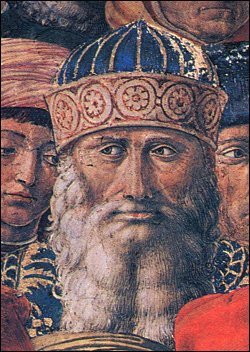
The above is an interesting story, but can we determine how Botticelli might have come across this knowledge? To understand this we need to understand the cultural backdrop Botticelli found himself in.
Pletho, or the ‘Plato of Florence’, had been active in Florence and had been disseminating Greek wisdom. He was responsible, amongst many other things, for reintroducing the works of Plato back into Western Europe. He was involved in the founding of the New Platonic Academy of Florence with Ficino which sought to study the old widsom. Ficino, incidentally, was responsible for translating the Corpus Hermeticum into Latin, the work which went on to inspire the work of Newton and many others.
“This century, like a golden age, has restored to light the liberal arts, which were almost extinct: grammar, poetry, rhetoric, painting, sculpture, architecture, music … this century appears to have perfected astrology.” -Ficino, 1492
Sadly this academy appears to have collapsed into the study of Kabbalah in an attempt to bring Platonic ideas in line with Christianity. This can be seen in the work of Mirandola, the father of Christian Kabbalah, after the death of Pletho. It is my view that this error is in part responsible for the Western Occult becoming a mockery of itself and having gone round in meaningless circles for the past half a millennia. This is, in turn, partly responsible for the crisis of culture we find ourselves in today.
This academy, and this era, appears to have come to and end when at least two of the academy’s prominent members, including Mirandola, were assassinated in 1494 in violent Christian uprisings. This has been confirmed by recent forensic analysis of the bodies and we know they were both poisoned with arsenic.
Still, this painting, painted at some point around 1485, stands as a testament to a brief moment when the roses of the Goddess were cast to the wind. An act which continues to resonate with us to this very day.
BOTTICELLI THE MAGUS
Perhaps it is fitting that we let Botticelli himself have the last word on this. Below is one of his paintings, the Adoration of the Magi dated around 1475, roughly ten years before painting the Birth Of Venus. He has placed himself amongst the Magi as they have, apparently come to celebrate the birth of Christ. Perhaps there is another interpretation. He is the one to the right looking out of the painting.
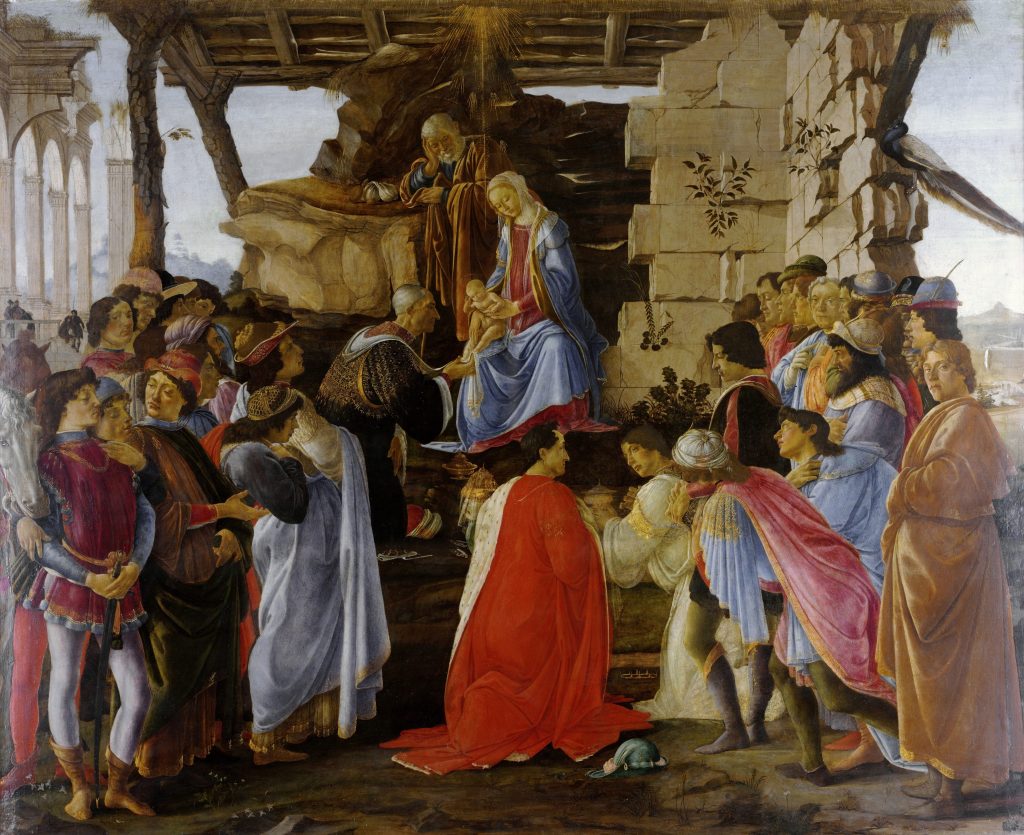
SO WHO WERE THE MAGI?
This is a deep question which will be discussed in later articles. Academically speaking they were the stargazing Zoroastrian priesthood however the term has taken on much wider significance in certain circles.
More broadly, they are the ancient hidden brother and sisterhood. They are the metaphorical carriers of the ancient wisdom, the so called Prisca Theologica. Magi, in this context, is a catch-all term for those who know the ancient wisdom or who uncover it themselves via the Perennial Philosophy. It has countless names. Some Sufi orders, for example, carry the knowledge. The Taoists carry the knowledge. Tantra carries the knowledge and doubtlessly many more that I do not know of.
If we look to the ancients, only fragmentary accounts of the Magi survive. If we look to the work of Diogenes Lertius (circa. 225AD), one of the rare existent reference to Aristotle’s lost book of magic he says:
“Some say the work of philosophy originated with the barbarians. For among the Persians are the Magi, among the Babylonians and Assyrians the Chaldeans, among the Indians the Gymnosophists (lit. naked philosophers), and among the Celts and Gauls, those called ‘Druids’ and holy people, according to what Aristotle says in the book on Magic and Sotion in the twenty-third book of the Succession of Philosophers.“
– Diogenes Laertius, Lives of the Eminent Philosophers, 1.1
And:
“The Magi were ignorant of sorcerers’ magic, says Aristotle in the book on Magic and Dinon in the fifth book of his Histories. He also says ‘Zoroaster’ when translated literally means ‘star-diviner’; Hermodorus says this as well. In the first book of On Philosophy, Aristotle says they (the Magi) are actually older than the Egyptians. And according to them there are two principles, a good daimon and a bad daimon: to the former, the name is Zeus and ‘Oromasdes’, to the other Hades and ‘Arimanius’. Hermippus says this too in the first book On Magi, so does Eudoxus in the Survey, and Theopompus in the eighth book of the Philippics.”
–Diogenes Laertius, Lives of the Eminent Philosophers, 1.7-8
It is, of course, a shame that we do not have the original text to evaluate and we must be cautious of taking Laertius at face value, however it does appear to show that the Magi were considered ancient by both the Greeks and apparently the Egyptians also. This perspective is echoed in some independent Arabic texts which have passed down to us via the Persian Sufi. We will discuss this at length in other articles.
Closer to home it also seems to have survived until recently in Ireland. Some say we find the fingerprints of the Magi in the Arthurian Legends such as in Merlin, we will discuss all this at length in later articles. I hold out hope that perhaps they may be some still out there, hidden, occulted, as is their way.
Through all this, one thing appears certain. The Birth Of Venus is a clear statement to us, across and through time, that in Florence in the middle ages, at this point in history, this knowledge manifested itself fully in the work of Botticelli. His work, of the most sublime and transcendent nature, has gone on to enchant the modern age and inspire countless millions with his testament to love and divine harmonic beauty. All of this whilst hidden in plain sight. A binding magic of the very highest order.
For this reason it is my opinion that he, beyond most, is worthy of the title.
BUT WHAT OF THE MAN?
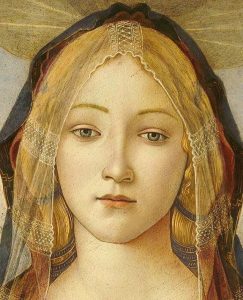
Whilst the above is an interesting story, there is a story more beautiful still. The legend goes that Botticelli had fallen in love with the wife of another man, Simonetta Vespucci (nee Cattaneo), the unparalleled one of Florence.
Upon her arrival in Florence and marriage to Marco Vespucci, she became the talk of the town as the most beautiful woman of her time. Botticelli was amongst those to admire her but might have fallen further into the sea of his emotions. It is said that he had fallen in love with her. She died after only a year in Florence, in 1476, leaving the city to mourn her.
She was carried through the streets in a glass coffin so the citizen could admire her beauty one final time. It is said that Botticelli used her memory in many of his subsequent works, most notably this one, the Birth of Venus. Regardless of his emotions I feel it is most likely that he would have used the most beautiful woman of his day as the model for the Goddess of Love and Beauty. I feel we are looking at a painting in part inspired by the beauty of Simonetta.
What we do know is that he never seems to have taken a lover again and that his last request was to be buried at her feet in Ognissanti, Florence, the chapel of the Vespuccis. The church, apparently familiar with the situation, are said to have allowed his request.
Over time the exact location of their graves have been forgotten so we will never know for sure. Even if we were to know I do not think they should be disturbed. However, one way or another, Botticelli lies with his muse, Simonetta, who’s beauty inspired such sublime work that we talk about it to this day. If there is truth to any of this, may they find immortality together.
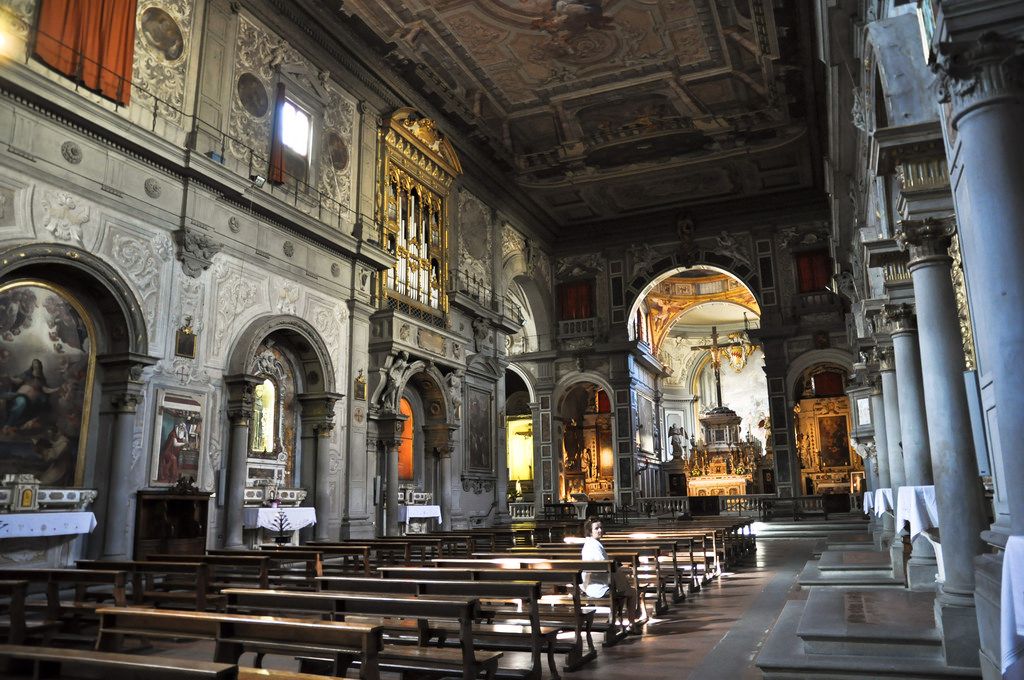
I do not know if this tale is true. But I like to think so. Should it be true in any measure, to talk of the Birth Of Venus without mentioning her name would be sacrilege.
So, with that said, Magus Botticelli and Simonetta the Beautiful, may your works echo through eternity.

